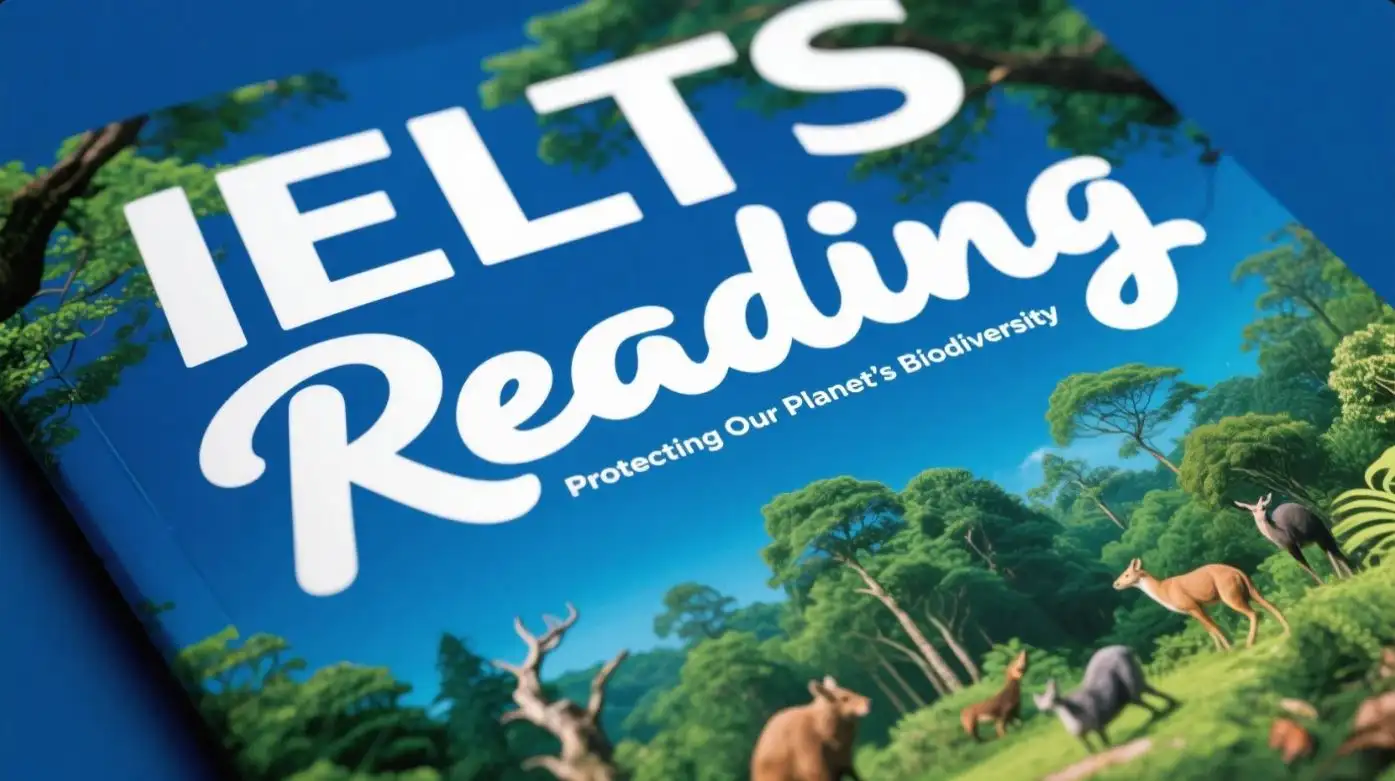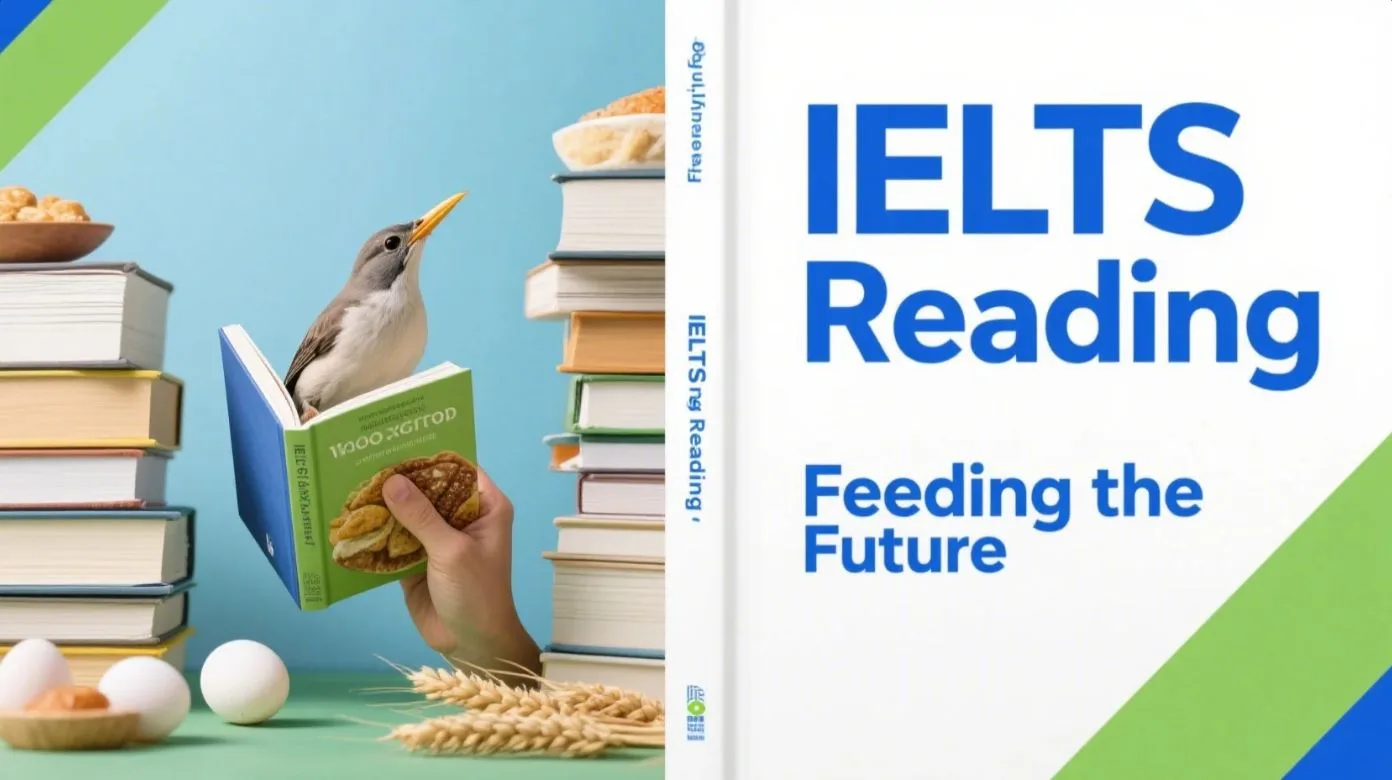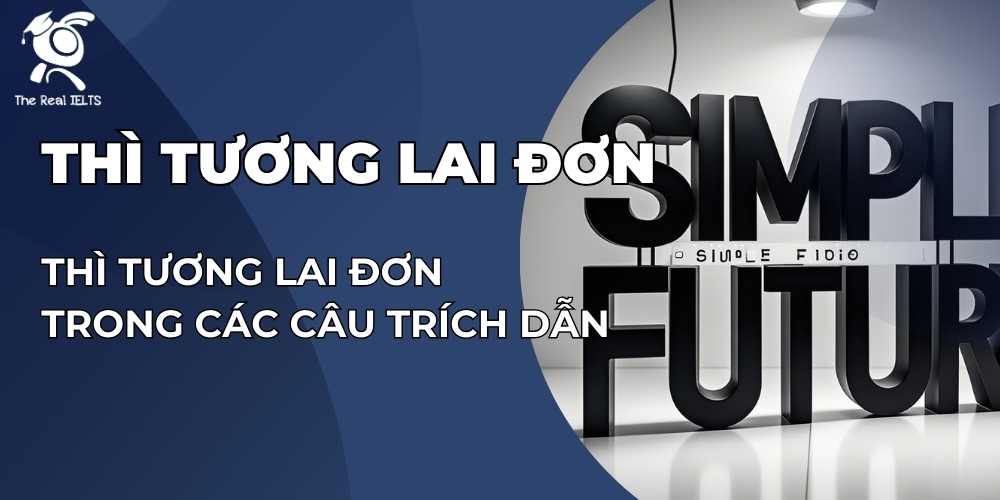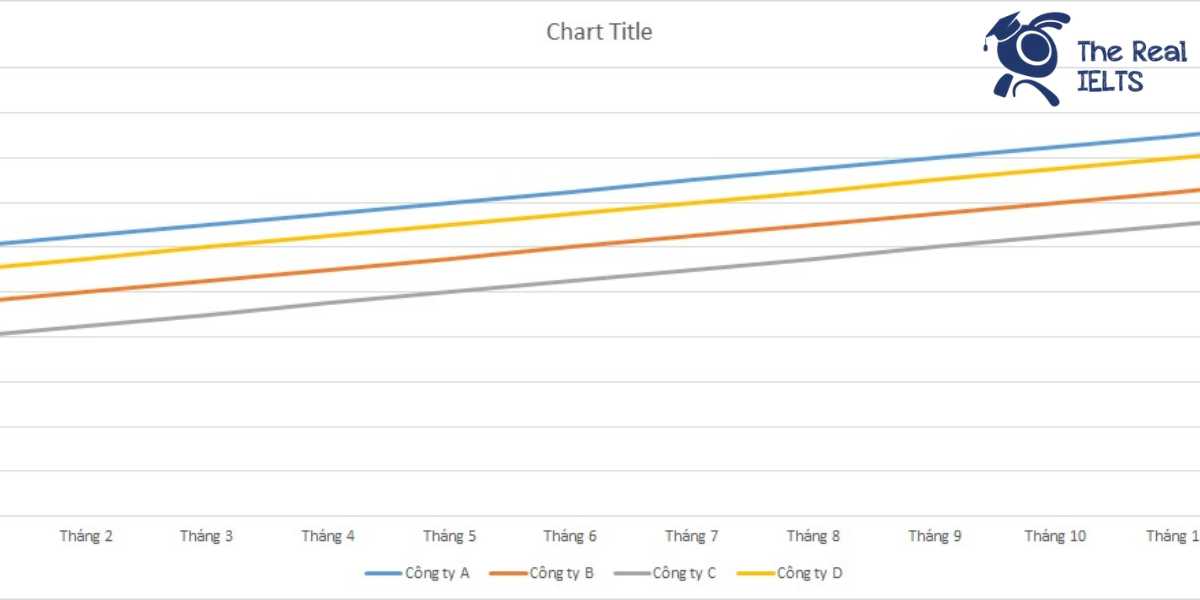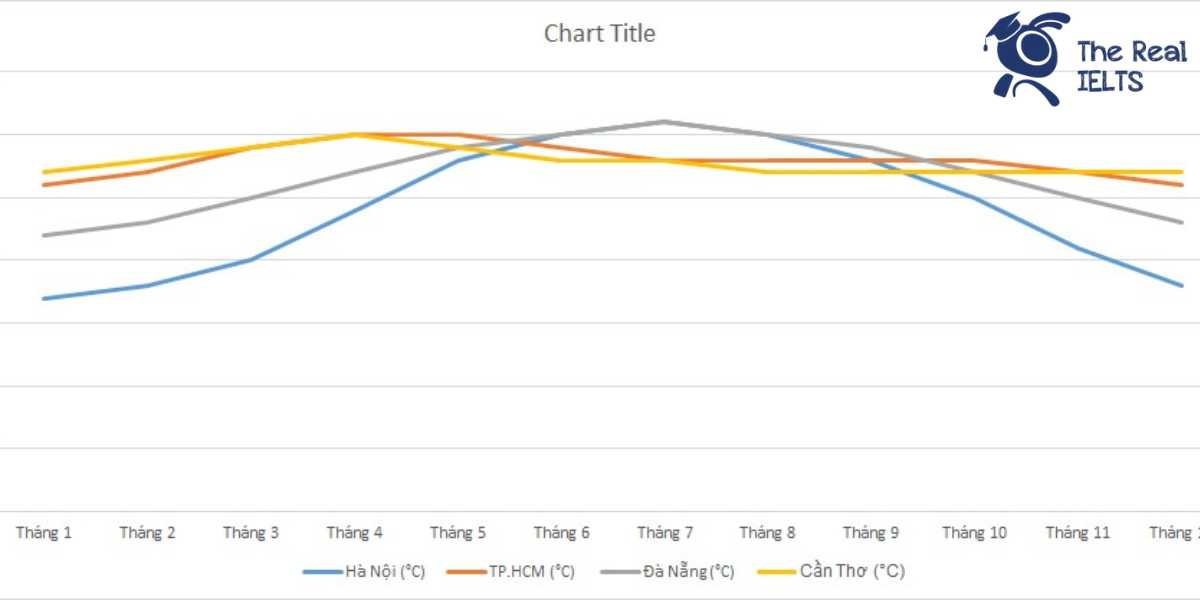Kỹ năng đọc hiểu trong kỳ thi IELTS đòi hỏi sự nhạy bén và phương pháp tiếp cận có hệ thống để xử lý các văn bản học thuật đa dạng. IELTS Reading không chỉ kiểm tra vốn từ mà còn đánh giá khả năng phân tích, suy luận và quản lý thời gian dưới áp lực. Với các bài đọc ngày càng phức tạp, thí sinh cần rèn luyện kỹ thuật đọc lướt và đọc chi tiết để tối ưu hóa hiệu suất và đạt band điểm cao.
Đọc thêm: IELTS Reading Practice Test: Air Pollution: A Global Challenge.
IELTS Reading Practice Test: Wildlife Conservation: Protecting Our Planet’s Biodiversity
Wildlife conservation is critical to preserving Earth’s biodiversity. As human activities like deforestation, poaching, and pollution threaten countless species, efforts to protect wildlife have intensified. Conservation programs focus on safeguarding endangered animals, such as the giant panda and the African elephant, by preserving their natural habitats. For example, national parks in Africa protect elephants from poaching, which has drastically reduced their populations over decades.
Habitat loss is the primary threat to wildlife, driven by urban expansion and agriculture. In the Amazon rainforest, logging has destroyed vast areas, endangering species like the jaguar. Conservationists advocate for reforestation and sustainable land use to mitigate these impacts. Additionally, climate change exacerbates threats, altering ecosystems and forcing species to adapt or migrate. Polar bears, for instance, struggle as Arctic ice melts, reducing their hunting grounds.
Governments and organizations worldwide are taking action. In 2023, over 190 countries committed to protecting 30% of the planet’s land and oceans by 2030 under a global biodiversity agreement. Zoos and wildlife sanctuaries also play a role, breeding endangered species and educating the public. However, critics argue that captive breeding may not fully replicate natural conditions, limiting its effectiveness. Despite challenges, technological advances, such as GPS tracking for monitoring animal movements, are aiding conservation efforts. By combining policy, technology, and community involvement, wildlife conservation aims to ensure a balanced ecosystem for future generations.
Câu hỏi
Questions 1–40
Question 1 (Multiple Choice)
What is the main goal of wildlife conservation programs?
A. To increase urban expansion
B. To protect endangered species and their habitats
C. To promote deforestation
D. To limit technological advancements
Question 2 (Multiple Choice)
Why are national parks in Africa important for elephants?
A. They provide breeding programs
B. They protect elephants from poaching
C. They increase agricultural land
D. They monitor climate change
Question 3 (True/False/Not Given)
The giant panda is no longer an endangered species.
A. True
B. False
C. Not Given
Question 4 (True/False/Not Given)
Habitat loss is caused by urban expansion and agriculture.
A. True
B. False
C. Not Given
Question 5 (Yes/No/Not Given)
Does the passage suggest that climate change affects wildlife habitats?
A. Yes
B. No
C. Not Given
Question 6 (Yes/No/Not Given)
Are zoos mentioned as a method to educate the public about wildlife?
A. Yes
B. No
C. Not Given
Question 7 (Matching Information)
Which paragraph discusses the impact of climate change on polar bears?
A. Paragraph 1
B. Paragraph 2
C. Paragraph 3
D. Paragraph 4
Question 8 (Matching Information)
In which paragraph is the global biodiversity agreement mentioned?
A. Paragraph 1
B. Paragraph 2
C. Paragraph 3
D. Paragraph 4
Question 9 (Matching Headings)
Choose the correct heading for Paragraph 1:
A. Threats to Wildlife
B. Introduction to Wildlife Conservation
C. Role of Technology in Conservation
D. Global Agreements for Biodiversity
Question 10 (Matching Headings)
Choose the correct heading for Paragraph 2:
A. Causes of Habitat Loss
B. Benefits of Zoos
C. Advances in Conservation Technology
D. Community Involvement in Conservation
Question 11 (Matching Sentence Endings)
National parks in Africa help elephants by …
A. reducing their hunting grounds.
B. protecting them from poaching.
C. promoting urban expansion.
D. altering their ecosystems.
Question 12 (Matching Sentence Endings)
Climate change affects polar bears because …
A. it encourages reforestation.
B. it melts Arctic ice, reducing their hunting grounds.
C. it increases agricultural activities.
D. it limits captive breeding programs.
Question 13 (Sentence Completion)
Wildlife conservation aims to preserve Earth’s _______.
Question 14 (Sentence Completion)
Logging in the Amazon rainforest endangers species like the _______.
Question 15 (Summary Completion)
Complete the summary using words from the passage:
Conservation efforts focus on protecting endangered species and preserving their _______ habitats.
Question 16 (Summary Completion)
In 2023, countries agreed to protect 30% of the planet’s _______ and oceans by 2030.
Question 17 (Diagram Label Completion)
Label the diagram of a conservation tool:
The technology used to monitor animal movements is called _______ tracking.
Question 18 (Diagram Label Completion)
Label the diagram of a conservation area:
A protected area for wildlife mentioned in the passage is called a _______ park.
Question 19 (Short Answer Questions)
What is one cause of habitat loss mentioned in the passage?
Question 20 (Short Answer Questions)
What percentage of the planet’s land and oceans did countries agree to protect by 2030?
Question 21 (Table Completion)
Complete the table below with information from the passage:
| Species | Threat | Conservation Measure |
|---|---|---|
| African Elephant | Poaching | _____________ |
| Jaguar | _____________ | Reforestation |
| Polar Bear | Melting Arctic ice | _____________ |
Question 22 (Multiple Choice)
What is a limitation of captive breeding according to the passage?
A. It fully replicates natural conditions
B. It may not be as effective as natural habitats
C. It prevents public education
D. It eliminates the need for national parks
Question 23 (True/False/Not Given)
Over 190 countries banned deforestation in 2023.
A. True
B. False
C. Not Given
Question 24 (Yes/No/Not Given)
Does the passage indicate that technology is used in wildlife conservation?
A. Yes
B. No
C. Not Given
Question 25 (Matching Information)
Which paragraph mentions the role of zoos in conservation?
A. Paragraph 1
B. Paragraph 2
C. Paragraph 3
D. Paragraph 4
Question 26 (Matching Headings)
Choose the correct heading for Paragraph 3:
A. Habitat Loss and Solutions
B. Global and Local Conservation Efforts
C. Challenges of Captive Breeding
D. Impact of Climate Change
Question 27 (Sentence Completion)
Polar bears are affected by the melting of _______ ice.
Question 28 (Summary Completion)
Wildlife sanctuaries contribute to conservation by _______ endangered species.
Question 29 (Short Answer Questions)
What is one technological tool mentioned for monitoring wildlife?
Question 30 (Diagram Label Completion)
Label the diagram of a conservation strategy:
Planting trees to restore habitats is called _______.
Question 31 (Multiple Choice)
What is one human activity threatening wildlife mentioned in the passage?
A. Reforestation
B. Captive breeding
C. Poaching
D. Public education
Question 32 (True/False/Not Given)
Wildlife sanctuaries are more effective than national parks.
A. True
B. False
C. Not Given
Question 33 (Yes/No/Not Given)
Does the passage suggest that community involvement is important for conservation?
A. Yes
B. No
C. Not Given
Question 34 (Matching Sentence Endings)
Conservationists advocate for reforestation to …
A. increase urban expansion.
B. mitigate habitat loss.
C. reduce public education efforts.
D. promote climate change.
Question 35 (Sentence Completion)
Over 190 countries committed to a _______ agreement in 2023.
Question 36 (Summary Completion)
Complete the summary:
Human activities like deforestation and _______ threaten wildlife, requiring global conservation efforts.
Question 37 (Short Answer Questions)
Name one species mentioned in the passage affected by habitat loss in the Amazon.
Question 38 (Table Completion)
Complete the table below with information from the passage:
| Threat | Example Species | Solution |
|---|---|---|
| Poaching | African Elephant | National parks |
| Habitat loss | _______________ | _______________ |
| Climate change | Polar Bear | Monitoring technology |
Question 39 (Multiple Choice)
What is one role of zoos mentioned in the passage?
A. They replace natural habitats completely
B. They educate the public about wildlife
C. They prevent climate change
D. They increase poaching activities
Question 40 (True/False/Not Given)
The jaguar is only found in the Amazon rainforest.
A. True
B. False
C. Not Given
Đáp án và Giải thích
Question 1
Correct Option: B
Explanation: Bài đọc nêu rằng mục tiêu chính của các chương trình bảo tồn là “safeguarding endangered animals… by preserving their natural habitats.” Lựa chọn B đúng vì nó phản ánh mục tiêu này. Các lựa chọn khác không đúng hoặc mâu thuẫn với bài đọc.
Question 2
Correct Option: B
Explanation: Bài đọc giải thích rằng các công viên quốc gia ở Châu Phi “protect elephants from poaching.” Lựa chọn B đúng vì khớp với thông tin này. Các lựa chọn khác không được đề cập hoặc không chính xác.
Question 3
Correct Option: C
Explanation: Bài đọc đề cập đến gấu trúc lớn (giant panda) như một loài nguy cấp nhưng không nói rõ liệu nó có còn là loài nguy cấp hay không. Thông tin này là “Not Given.”
Question 4
Correct Option: A
Explanation: Bài đọc nêu rằng “Habitat loss is the primary threat to wildlife, driven by urban expansion and agriculture.” Câu này đúng vì thông tin khớp với bài đọc.
Question 5
Correct Option: A
Explanation: Bài đọc đề cập rằng biến đổi khí hậu “altering ecosystems” và ảnh hưởng đến các loài như gấu Bắc Cực. Câu trả lời là “Yes” vì thông tin này được nêu rõ.
Question 6
Correct Option: A
Explanation: Bài đọc nêu rằng “Zoos and wildlife sanctuaries also play a role, breeding endangered species and educating the public.” Câu trả lời là “Yes” vì vai trò giáo dục công chúng được đề cập.
Question 7
Correct Option: B
Explanation: Tác động của biến đổi khí hậu đến gấu Bắc Cực được thảo luận ở đoạn 2: “Polar bears, for instance, struggle as Arctic ice melts.” Đáp án đúng là B.
Question 8
Correct Option: C
Explanation: Thỏa thuận đa dạng sinh học toàn cầu được đề cập ở đoạn 3: “In 2023, over 190 countries committed to protecting 30% of the planet’s land and oceans by 2030.” Đáp án đúng là C.
Question 9
Correct Option: B
Explanation: Đoạn 1 giới thiệu về bảo tồn động vật hoang dã, nhấn mạnh tầm quan trọng và các mối đe dọa như săn trộm, ô nhiễm. Tiêu đề “Introduction to Wildlife Conservation” phù hợp nhất.
Question 10
Correct Option: A
Explanation: Đoạn 2 tập trung vào nguyên nhân mất môi trường sống, như “urban expansion and agriculture,” và các giải pháp như tái trồng rừng. Tiêu đề “Causes of Habitat Loss” là phù hợp.
Question 11
Correct Option: B
Explanation: Bài đọc nêu rằng “national parks in Africa protect elephants from poaching.” Lựa chọn B khớp với thông tin này.
Question 12
Correct Option: B
Explanation: Bài đọc giải thích rằng biến đổi khí hậu ảnh hưởng đến gấu Bắc Cực vì “Arctic ice melts, reducing their hunting grounds.” Lựa chọn B đúng.
Question 13
Correct Answer: biodiversity
Explanation: Bài đọc nêu rằng bảo tồn động vật hoang dã nhằm “preserving Earth’s biodiversity.” Từ “biodiversity” phù hợp để điền vào chỗ trống.
Question 14
Correct Answer: jaguar
Explanation: Bài đọc đề cập rằng “logging has destroyed vast areas, endangering species like the jaguar” ở rừng Amazon. Từ “jaguar” là đúng.
Question 15
Correct Answer: natural
Explanation: Bài đọc nêu rằng bảo tồn tập trung vào “preserving their natural habitats.” Từ “natural” phù hợp với tóm tắt.
Question 16
Correct Answer: land
Explanation: Bài đọc đề cập rằng các quốc gia cam kết bảo vệ “30% of the planet’s land and oceans by 2030.” Từ “land” phù hợp để điền vào.
Question 17
Correct Answer: GPS
Explanation: Bài đọc nêu rằng “GPS tracking” được sử dụng để theo dõi chuyển động của động vật. Từ “GPS” là đúng.
Question 18
Correct Answer: national
Explanation: Bài đọc đề cập đến “national parks” như một khu vực bảo vệ động vật hoang dã. Từ “national” là đúng.
Question 19
Correct Answer: Deforestation
Explanation: Bài đọc liệt kê “deforestation” là một nguyên nhân gây mất môi trường sống. Đáp án này khớp với thông tin.
Question 20
Correct Answer: 30%
Explanation: Bài đọc nêu rằng các quốc gia cam kết bảo vệ “30% of the planet’s land and oceans by 2030.” Đáp án này chính xác.
Question 21
Correct Answers:
- African Elephant Conservation Measure: National parks
- Jaguar Threat: Logging
- Polar Bear Conservation Measure: Monitoring technology
Explanation: - Bài đọc nêu rằng voi Châu Phi được bảo vệ bởi “national parks.”
- Báo đốm bị đe dọa bởi “logging” ở rừng Amazon.
- Gấu Bắc Cực được hỗ trợ bởi công nghệ như “GPS tracking” (monitoring technology).
Question 22
Correct Option: B
Explanation: Bài đọc nêu rằng “captive breeding may not fully replicate natural conditions, limiting its effectiveness.” Lựa chọn B đúng vì nó phản ánh hạn chế này.
Question 23
Correct Option: C
Explanation: Bài đọc không đề cập đến việc cấm phá rừng vào năm 2023, mà chỉ nói về cam kết bảo vệ 30% đất và đại dương. Thông tin này là “Not Given.”
Question 24
Correct Option: A
Explanation: Bài đọc đề cập đến “technological advances, such as GPS tracking” trong bảo tồn. Câu trả lời là “Yes.”
Question 25
Correct Option: C
Explanation: Vai trò của sở thú được thảo luận ở đoạn 3: “Zoos and wildlife sanctuaries also play a role, breeding endangered species and educating the public.” Đáp án đúng là C.
Question 26
Correct Option: B
Explanation: Đoạn 3 thảo luận về các nỗ lực bảo tồn toàn cầu và địa phương, bao gồm thỏa thuận đa dạng sinh học và vai trò của sở thú. Tiêu đề “Global and Local Conservation Efforts” phù hợp nhất.
Question 27
Correct Answer: Arctic
Explanation: Bài đọc nêu rằng gấu Bắc Cực bị ảnh hưởng bởi “Arctic ice melts.” Từ “Arctic” phù hợp để điền vào.
Question 28
Correct Answer: breeding
Explanation: Bài đọc nêu rằng khu bảo tồn động vật hoang dã đóng góp bằng cách “breeding endangered species.” Từ “breeding” phù hợp.
Question 29
Correct Answer: GPS tracking
Explanation: Bài đọc đề cập đến “GPS tracking” như một công cụ công nghệ để theo dõi động vật. Đáp án này chính xác.
Question 30
Correct Answer: reforestation
Explanation: Bài đọc nêu rằng “reforestation” là một giải pháp để giảm thiểu mất môi trường sống. Từ “reforestation” là đúng.
Question 31
Correct Option: C
Explanation: Bài đọc liệt kê “poaching” là một hoạt động của con người đe dọa động vật hoang dã. Lựa chọn C đúng.
Question 32
Correct Option: C
Explanation: Bài đọc không so sánh hiệu quả của khu bảo tồn động vật hoang dã với công viên quốc gia. Thông tin này là “Not Given.”
Question 33
Correct Option: A
Explanation: Bài đọc đề cập rằng bảo tồn kết hợp “community involvement,” ngụ ý rằng sự tham gia của cộng đồng là quan trọng. Câu trả lời là “Yes.”
Question 34
Correct Option: B
Explanation: Bài đọc nêu rằng các nhà bảo tồn ủng hộ “reforestation and sustainable land use to mitigate these impacts” (mất môi trường sống). Lựa chọn B đúng.
Question 35
Correct Answer: biodiversity
Explanation: Bài đọc đề cập đến “global biodiversity agreement” vào năm 2023. Từ “biodiversity” phù hợp để điền vào.
Question 36
Correct Answer: poaching
Explanation: Bài đọc liệt kê “deforestation and poaching” là các hoạt động của con người đe dọa động vật hoang dã. Từ “poaching” phù hợp.
Question 37
Correct Answer: Jaguar
Explanation: Bài đọc đề cập rằng báo đốm (jaguar) bị đe dọa bởi mất môi trường sống ở rừng Amazon. Đáp án này đúng.
Question 38
Correct Answers:
- Habitat loss Example Species: Jaguar
- Habitat loss Solution: Reforestation
Explanation: - Bài đọc nêu rằng báo đốm (jaguar) bị đe dọa bởi “logging” (mất môi trường sống).
- Giải pháp cho mất môi trường sống là “reforestation,” như được đề cập trong bài.
Question 39
Correct Option: B
Explanation: Bài đọc nêu rằng sở thú “educating the public” về động vật hoang dã. Lựa chọn B đúng vì nó phản ánh vai trò này.
Question 40
Correct Option: C
Explanation: Bài đọc đề cập đến báo đốm ở rừng Amazon nhưng không nói rằng nó chỉ được tìm thấy ở đó. Thông tin này là “Not Given.”


